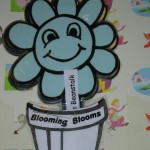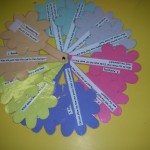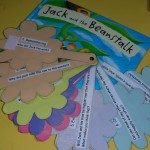
Blooming Blooms
In 2009 Katrina Little, the nursery teacher at Kilmacolm Nursery (which is part of Kilmacolm Primary School) using Bloom’s Taxonomy worked with parents to form Blooming Bloom Questions for familiar fairytales so that the children are introduced to the benefits of questioning (Innovative approaches). See Blooming Blooms example questions for Goldilocks and The Three Bears.
The questions are colour coded to represent the different parts of Bloom’s Taxonomy and attached to the responding coloured flower and put into a pot which is inside the front of each book (see above picture).
The questions are there to reinforce that the activitiy is not just about reading the book but about gaining knowledge and understanding, applying, analysing and evaluating what has been heard and then creating new thoughts. It is also about fully involving the parents in their children’s learning.
A visit to the nursery on Wednesday (17th February 2010) saw Katrina and the children in action. The story was Jack and the Beanstalk and I joined the children (a preschool group of 4 years old) as Katrina started to question them using the Blooming Blooms questions (copy of original Jack and the Beanstalk Questions).
Unfortunately Katrina didn’t get through all of the questions as a group of younger children had finished their activity and had returned to the nursery. This disrupted the older childrens concentration a bit.
The books also go home with the children on a Friday so that the parents can be involved in the learning activity. Reports indicate that parents are enjoying using the Blooming Bloom questions and children enjoy them too.
This has lead to plans which are under way to introduce Blooming Blooms in Primary 1 linking it to their reading bookings and the Oxford Reading Tree. Those parents that were involved in the nursery project are said to be keen to be involved in the extension to Primary 1.
My thanks to Mrs Katrina Little, colleagues in the nursery and children at Kilmacolm Nursery and the headteacher for allowing me into their world.




